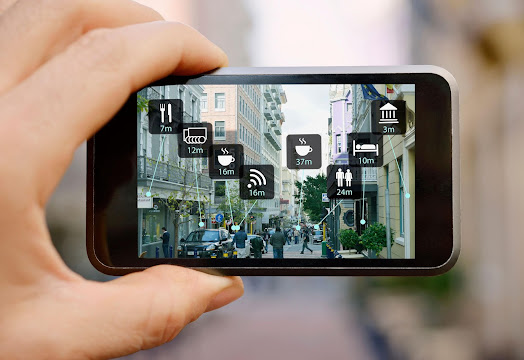The future of how we see things "Augmented Reality"
Augmented reality (AR) is a technology that overlays digital information, such as images, sounds, and 3D models, onto the real world in real-time. AR can be experienced through devices such as smartphones, tablets, smart glasses, or head-mounted displays. By using computer vision, AR technology can recognize and track real-world objects and then overlay digital information on top of them. This technology has many practical applications, including gaming, education, healthcare, and manufacturing.
Augmented
reality (AR) has numerous practical applications across various industries,
including:
Gaming
and Entertainment: AR can enhance the gaming experience by overlaying digital information
on the real world. For example, Pokémon Go is a popular AR game that allows
players to catch digital creatures in the real world.
Education
and Training: AR
can be used to create immersive and interactive learning experiences. For
example, medical students can use AR to visualize and study the human anatomy.
Retail
and Advertising:
AR can enhance the shopping experience by allowing customers to try on clothes or
see how furniture would look in their homes before making a purchase.
Manufacturing
and Engineering:
AR can be used to improve assembly line processes by overlaying digital
instructions on top of real-world machinery.
Healthcare: AR can assist healthcare
professionals with tasks such as surgery and diagnosis by providing real-time
information and visualizations.
Architecture
and Construction:
AR can be used to visualize and simulate building designs and construction
projects in the real world.
Tourism
and Travel: AR
can enhance the tourism experience by providing virtual guides and interactive
maps.
The
potential applications of AR are vast, and as the technology continues to
evolve, we can expect to see more innovative and practical use cases in various
industries.
Cost of augmented reality
The cost of
augmented reality (AR) can vary widely depending on the application, platform,
and device used. Here are some factors that can impact the cost of AR:
Development
Costs: Developing an
AR application requires specialized skills and expertise in areas such as
computer vision, 3D modeling, and software development. The cost of hiring
developers and designers will depend on their experience and location.
Hardware
Costs: The cost of
hardware required to experience AR can vary depending on the device used. For
example, AR can be experienced through smartphones, tablets, smart glasses, or
head-mounted displays, each with varying costs.
Licensing
Fees: Some AR
platforms or software may require licensing fees to use their technology.
Maintenance
and Updates: AR
applications require regular maintenance and updates to ensure they continue to
operate effectively and provide a seamless user experience.
The cost of
AR can be significant, especially for businesses and organizations that require
customized solutions. However, as AR technology continues to evolve and become
more accessible, we can expect to see a wider range of affordable solutions
that make AR more accessible to a broader audience.
Teaching
of Augmented Reality in Schools
Schools can
conduct classes on augmented reality (AR) in various ways, depending on the
resources available and the age group of the students. Here are some examples:
Use of
Mobile Devices:
Students can use their smartphones or tablets to experience AR applications
related to the subject they are studying. For example, they can use AR apps to
visualize complex scientific concepts, such as the human anatomy or the solar
system.
Interactive
Whiteboards:
Interactive whiteboards equipped with AR technology can allow students to
engage with AR content and interact with it using gestures or other input
devices.
Dedicated
AR Hardware: Some
schools may have access to specialized AR hardware, such as head-mounted
displays or smart glasses, that can provide a more immersive AR experience.
AR Field
Trips: Schools can
conduct AR-enhanced field trips that allow students to explore and learn about
different places, such as museums, historical sites, or nature reserves.
Maker
Spaces: Maker spaces
equipped with AR technology can allow students to design and create their own
AR experiences and projects.
Integrating
AR into the classroom can enhance students' engagement and understanding of
various subjects by providing a more interactive and immersive learning
experience. However, it's important to ensure that AR is used in a way that
aligns with educational goals and supports student learning outcomes.
Drawbacks
of Augmented Reality
While
augmented reality (AR) has many potential benefits, it also has some drawbacks,
including:
Technical
Limitations: AR
technology is still evolving, and some applications may require significant
hardware and software resources, such as processing power, memory, and storage.
This can limit the accessibility and usability of AR applications, especially
on older or less powerful devices.
Cost: As mentioned earlier, the cost of
developing and implementing AR applications can be significant, especially for
customized or enterprise-level solutions.
Health
Risks: Extended use
of AR can cause eye strain, headaches, and other health problems, especially
when using head-mounted displays or other specialized hardware.
Privacy
Concerns: AR
applications can collect and transmit data about users, such as their location,
behavior, and preferences. This can raise privacy concerns, especially when
used by third-party developers or companies.
Distractions: AR applications can be highly
engaging and immersive, but this can also be a distraction, especially in
contexts that require concentration or attention, such as driving, studying, or
working.
These
drawbacks highlight the need for careful consideration and responsible use of
AR technology, especially in educational, business, and public settings. It's
important to balance the benefits of AR with the potential risks and
limitations to ensure that it's used in a safe and effective way.





Comments
Post a Comment